
34-2. parcella
Semmelweis Ignác kenotáfiuma, mészkő és márvány, 1894 (34/2-1-1)
Építészek: Herczog Fülöp, Schickedanz Albert
 A híres magyar orvosnak, az „anyák megmentőjeként” ismert Semmelweis Ignácnak egykori sírhelyét jelöli a díszes kőszarkofág, amely a negyedik temetkezési helye volt. A schmelzi temetőben temették el először, majd maradványait átszállították felesége családjának, a Whaltier családnak a kriptájába (jobb oldali falsírboltok 109.). Az orvos második exhumálására 1894. április 24-én került sor, ekkor díszsírhelyet jelöltek ki számára a temető 21-es parcellájában, amelyre síremlékül Schickedanz Albert és Herczog Fülöp alkotása, egy díszes szarkofág került. Onnét az 1929-ben kialakított díszparcellákba temették át és helyezték maradványai fölé a díszes szarkofágot.
A híres magyar orvosnak, az „anyák megmentőjeként” ismert Semmelweis Ignácnak egykori sírhelyét jelöli a díszes kőszarkofág, amely a negyedik temetkezési helye volt. A schmelzi temetőben temették el először, majd maradványait átszállították felesége családjának, a Whaltier családnak a kriptájába (jobb oldali falsírboltok 109.). Az orvos második exhumálására 1894. április 24-én került sor, ekkor díszsírhelyet jelöltek ki számára a temető 21-es parcellájában, amelyre síremlékül Schickedanz Albert és Herczog Fülöp alkotása, egy díszes szarkofág került. Onnét az 1929-ben kialakított díszparcellákba temették át és helyezték maradványai fölé a díszes szarkofágot.
Az oroszlánfejes lábakon álló neoreneszánsz stílusban faragott szarkofág hosszanti oldalán az öröklétet szimbolizáló, borostyánnal körbefutott mezőben olvasható az orvos neve, míg a másik oldalon a születési és halálozási dátuma. A díszes sírláda két rövidebb oldalán babérkoszorúval övezett gyöngysoros körben az orvoslást szimbolizáló Aszklépiosz kígyója utal az elhunyt hivatására.
Semmelweis Ignác földi maradványait halálának 100. évfordulóján 1965-ben helyezték el végsőnek szánt nyughelyére, egykori szülőháza (ma Semmelweis Orvostörténeti Múzeum) udvarának kőfalába. Az impozáns síremlék mai napig megemlékezések helyszínéül szolgál.
Medgyessy Ferenc síremléke, bronz, 1949 (34/2-1-9)
Szobrász: Medgyessy Ferenc
A Medgyessy Ferenc és felesége sírján látható szobrot a művész egyik fő műveként tartják számon.
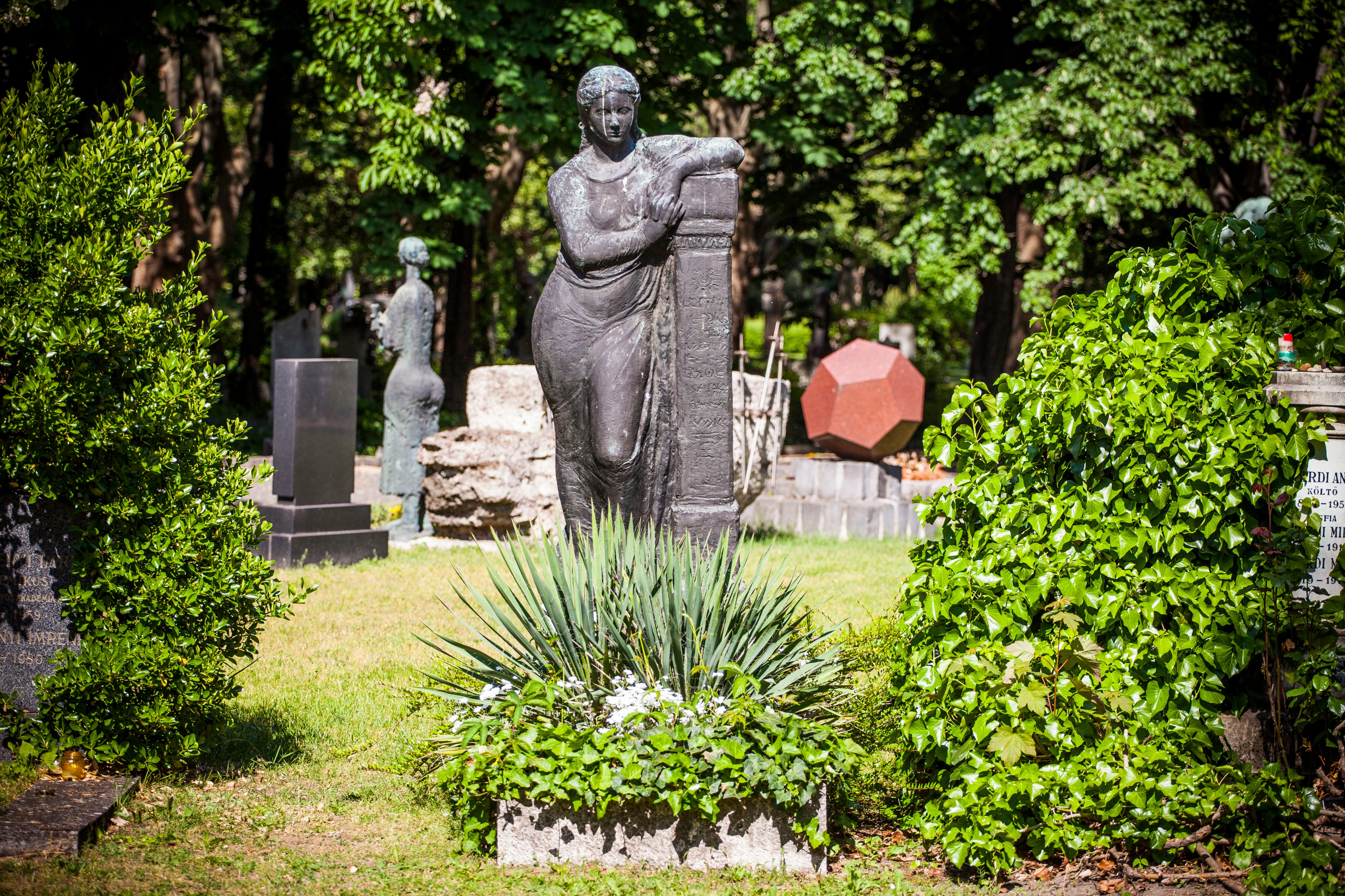 Sírszobornak készült eredetileg is: a neves műgyűjtő és gyorsíró, Radnai Béla felesége síremlékének megfaragására kérte fel a művészt. A műhelyben készülő szobrot meglátva Medgyessy felesége elgondolkozva mondta férjének: „Szeretem ezt a szobrot, szép lenne, ha ez állna kettőnk sírja felett.” A művész szűkszavúan ennyit felelt: „Lehet, jó szobor.”
Sírszobornak készült eredetileg is: a neves műgyűjtő és gyorsíró, Radnai Béla felesége síremlékének megfaragására kérte fel a művészt. A műhelyben készülő szobrot meglátva Medgyessy felesége elgondolkozva mondta férjének: „Szeretem ezt a szobrot, szép lenne, ha ez állna kettőnk sírja felett.” A művész szűkszavúan ennyit felelt: „Lehet, jó szobor.”
Az eredeti gipszszobor egy oszlopra támaszkodó, telt idomú női alakot ábrázol, amely egyike a Medgyessy életmű jellegzetes, kissé telt formájú, álló, ülő vagy fekvő, lágy redőzetű ruhát viselő női alakjainak. Érdekesség az oszlop felirata, amelyben rovásírásos jelek láthatóak. A művészt a magyarság kultúrájának részeként különösen foglalkoztatta a rovásírás története, ezért több alkotásán is megjelennek rovásjelek, először egy 1921-ben készített íjazó ifjút ábrázoló síremléken.
A szobrász a Radnai-féle, márványba faragott síremléken a megrendelő kívánsága szerint a női alak formáját karcsúsította, az oszlopról pedig elhagyta a rovásjeleket.
Az eredeti elképzelést megörökítő gipszszoborról több bronzpéldány is készült, így állíthattak ki egy másodpéldányt a debreceni Medgyessy Ferenc Emlékmúzeum udvarára, valamint a művész és feleségének sírjára is.
Lyka Károlyné (Minich Ida) és Lyka Károly sírja, márvány, 1931 (34/2-1-13)
Szobrász: Medgyessy Ferenc
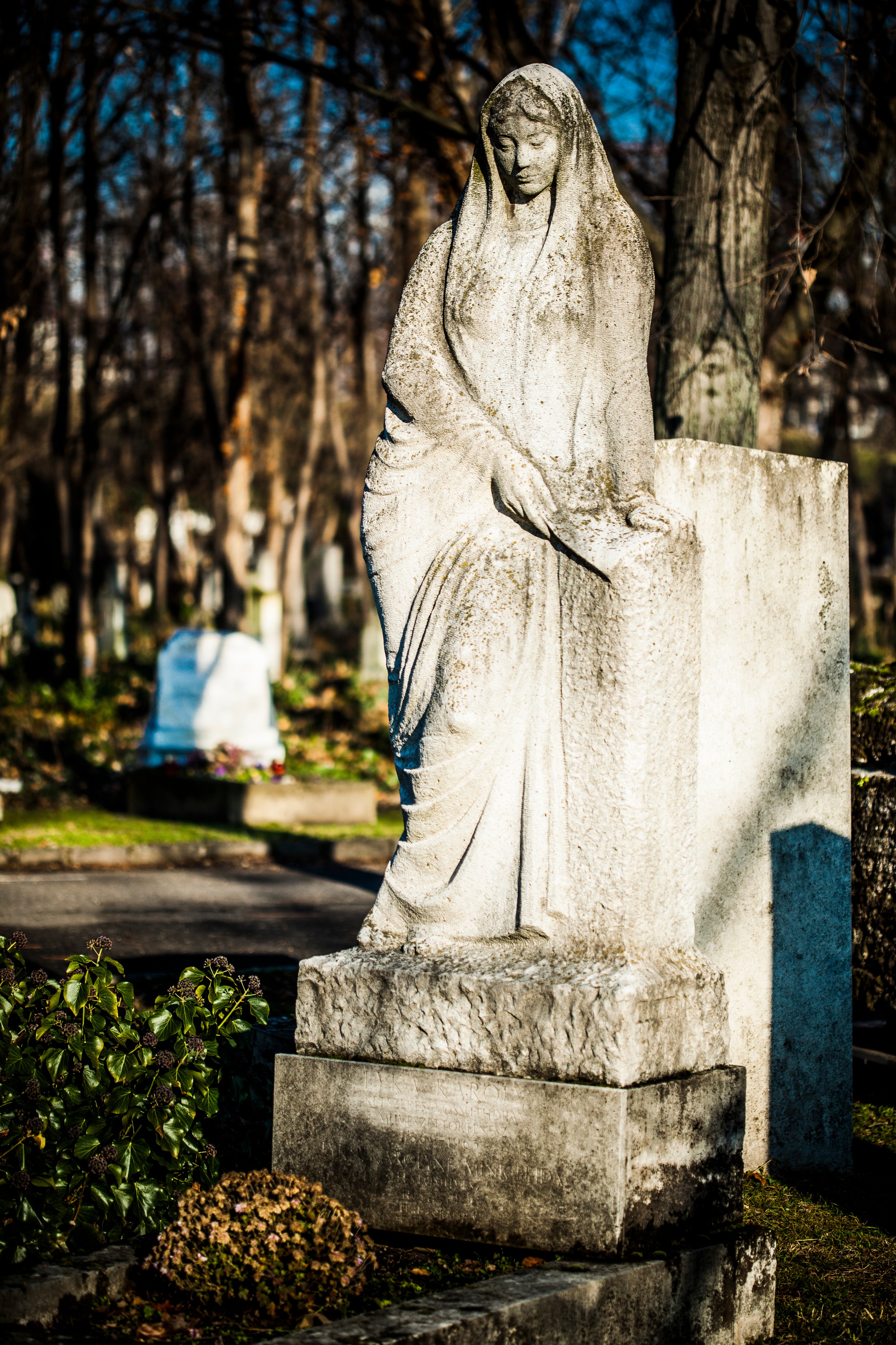 Medgyessy Ferenc funerális művészetének központi szereplői a női alakok, akik kontraposztos beállításban kőtömbre vagy oszlopra támaszkodnak, antik hatást keltő, áttetsző, asszonyosan telt formáikat kiemelő ruházatban. Ezek a síremlékek nagyon hasonlítanak egymásra, de mégis igen változatos megoldású kompozíciók.
Medgyessy Ferenc funerális művészetének központi szereplői a női alakok, akik kontraposztos beállításban kőtömbre vagy oszlopra támaszkodnak, antik hatást keltő, áttetsző, asszonyosan telt formáikat kiemelő ruházatban. Ezek a síremlékek nagyon hasonlítanak egymásra, de mégis igen változatos megoldású kompozíciók.
Az első ilyen sírszobor, amely egyben az első temetői munkája is volt Medgyessy Ferencnek, a Farkasréti temetőben nyugvó Lengyel Béla kémikus sírjára készült. A sorban következőt 1923-ban faragta Pechán József festő síremlékére a verbászi temetőbe. A debreceni gimnáziumi igazgató, Dóczi Imre sírszobrát fia rendelte meg a szobrásztól, de az 1931-ben készített tervekkel nem volt megelégedve. A márványból megfaragott, könyvet tartó, lepelbe burkolt, merengve maga elé néző női alak így végül 1943-ban Lyka Károlyné Minich Ida sírjára került. 1950-ben újabb nőalakos síremlék-kompozíció készült Radnai Béláné sírjára, és végül magának a szobrászművésznek a sírját is ennek a szobornak a bronz másodpéldánya jelöli.
A művész 1923-ban készített Támaszkodó című, ugyanilyen kompozíciójú, kisméretű női bronz aktszobrát a Nemzeti Galéria gyűjteménye őrzi.
Apám síremléke, Ferenczy Károly síremléke, bronz, 1961 (34/2-1-15)
Szobrász: Ferenczy Béni
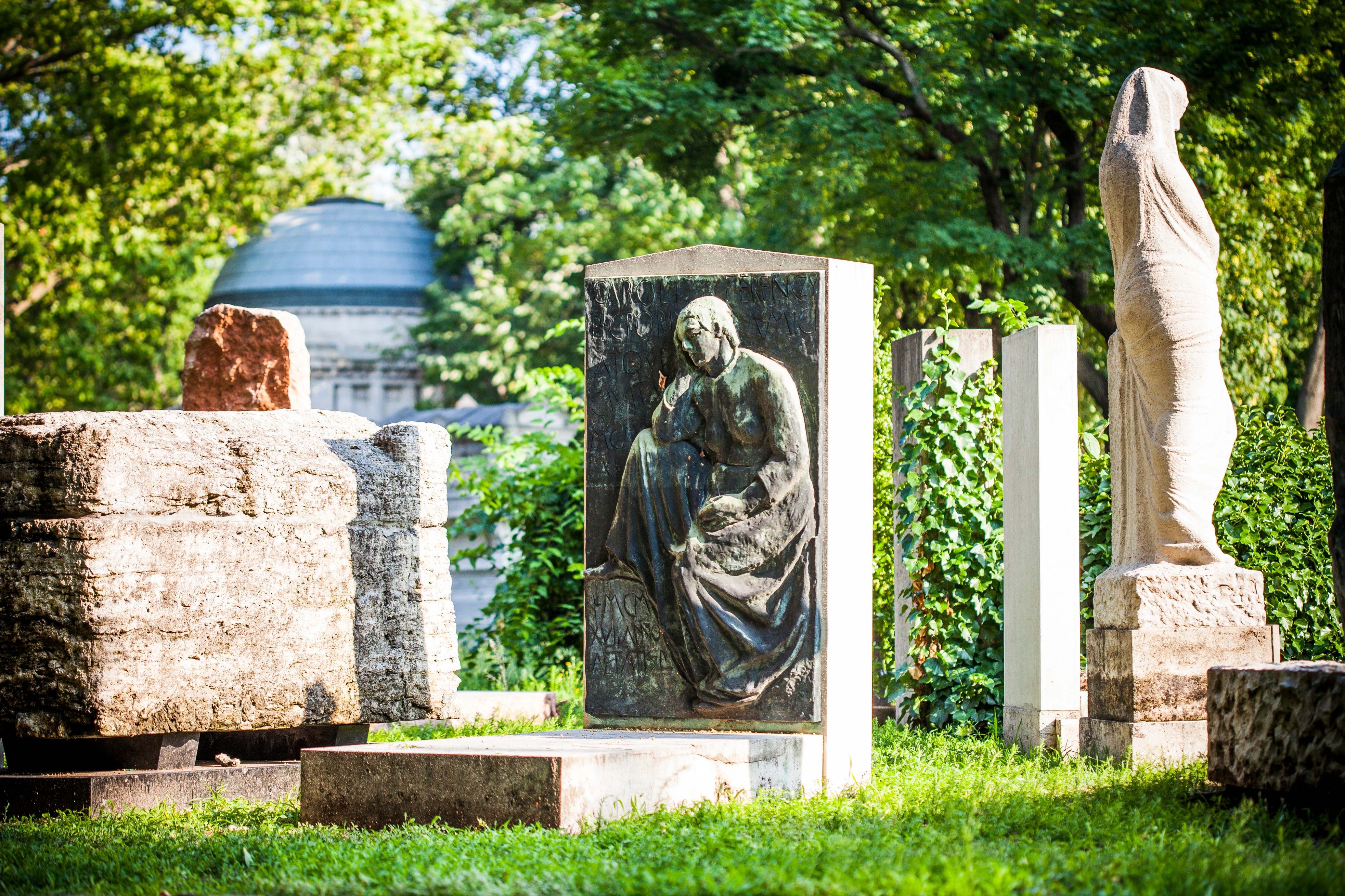 A Nagybányai festőiskola egyik alapítójának, Ferenczy Károlynak sírdomborművét fia, Béni készítette. A művész eredetileg az 1918-ban készített Szerelmespár című domborművét szánta apja sírjára, ám ennek bronzba öntésére már nem kerülhetett sor, mivel emigrálni kényszerült. A gipszdomborművet sok évtizeddel később, 2007-ben öntötték csak bronzba, és helyezték el a Pesti Vigadó épületének falán. A második világháború után ismét hozzálátott apja síremlékének tervezéséhez, ezt súlyos betegsége, agyi embóliája miatt kellett abbahagynia. Felgyógyulva, jobb kezére bénán folytatta apja síremlékdomborművének készítését. A kivitelezés költségeit a főváros vállalta fel, így az emlék felállítására a festőművész születésének 100. évfordulóján került sor.
A Nagybányai festőiskola egyik alapítójának, Ferenczy Károlynak sírdomborművét fia, Béni készítette. A művész eredetileg az 1918-ban készített Szerelmespár című domborművét szánta apja sírjára, ám ennek bronzba öntésére már nem kerülhetett sor, mivel emigrálni kényszerült. A gipszdomborművet sok évtizeddel később, 2007-ben öntötték csak bronzba, és helyezték el a Pesti Vigadó épületének falán. A második világháború után ismét hozzálátott apja síremlékének tervezéséhez, ezt súlyos betegsége, agyi embóliája miatt kellett abbahagynia. Felgyógyulva, jobb kezére bénán folytatta apja síremlékdomborművének készítését. A kivitelezés költségeit a főváros vállalta fel, így az emlék felállítására a festőművész születésének 100. évfordulóján került sor.
A domborművön egy térdére könyöklő nő ül, arcát kezén támasztja, maga elé néz, gondolataiba mélyed. Gyász, csendes belenyugvás, elengedés, emlékezés juthat eszünkbe a kompozícióról. Az ülő nő körül latin felirat: Caroli Ferenczy Pictori Amici Atque Civitas MCMLXI + MCMXVII Anno Aetatis L.
Ad Astra (Csillagok felé), Kisfaludi Strobl Zsigmond sírja, bronz, 1922 (34/2-1-27)
Szobrász: Kisfaludi Strobl Zsigmond
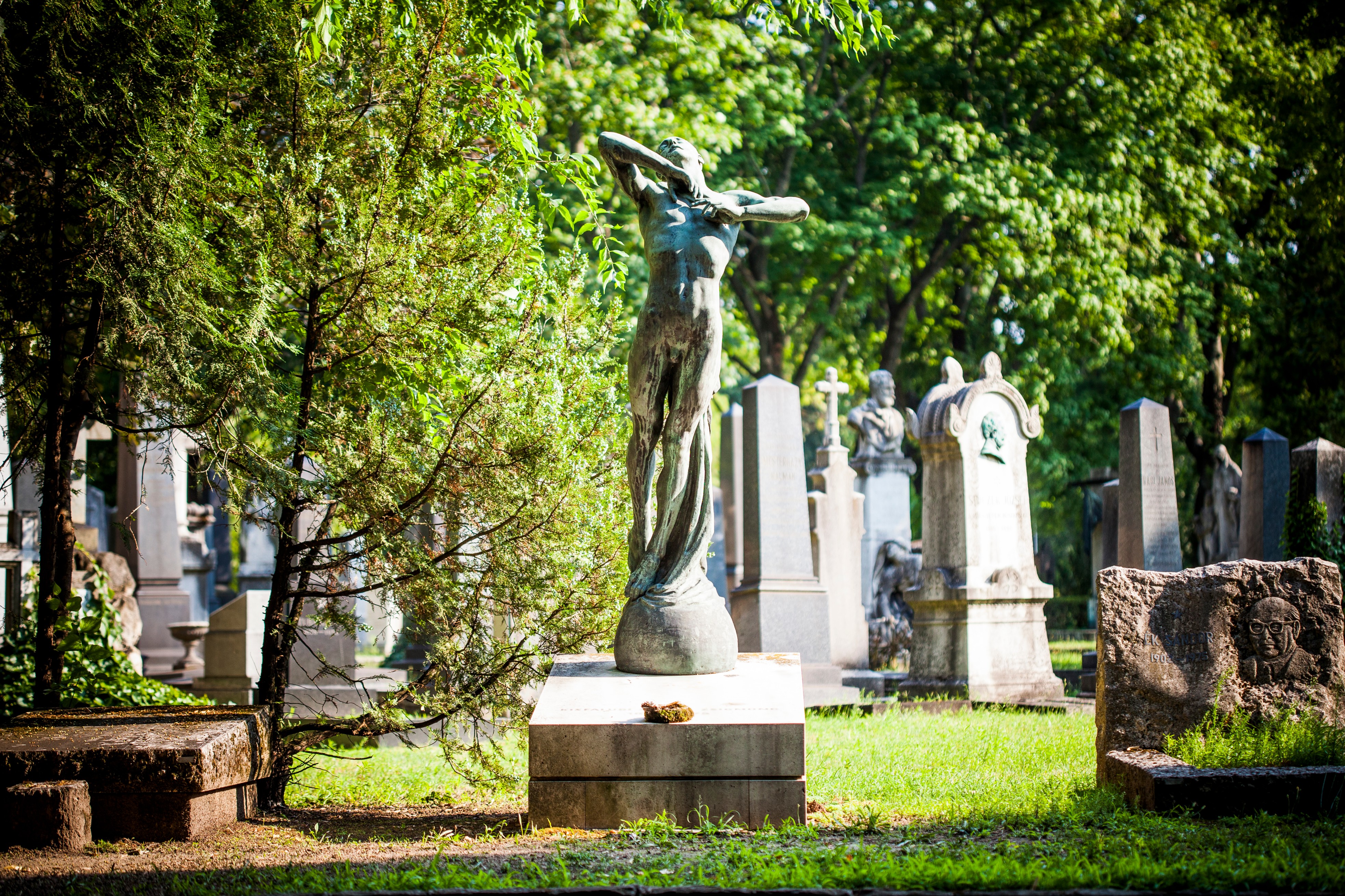 A szobrászművész végrendelete alapján állították sírjára egyik híres alkotásának, az Ad Astrának bronz öntvényét.
A szobrászművész végrendelete alapján állították sírjára egyik híres alkotásának, az Ad Astrának bronz öntvényét.
A szobor gipsz eredetijét az 1922-es Szinyei Merse Pál Társaság szervezte kiállításon mutatta be a művész. Többek között ezt a szobrot is kiállították az 1937-es párizsi világkiállításon a magyar pavilon kertjében az épület bejárata előtt. A zsűri az alkotást Diploˆme d’Honneur kitüntetésben (a nagydíjat követő legrangosabb elismerésben) részesítette.
A szobor egy földgömbön álló ifjút ábrázol, aki szívére szorított kezekkel az ég felé fordul, útra készen az ismeretlen végtelen felé, a „csillagok közé”, mintegy új lét-teret keresve az emberi léleknek. A kompozíció az öröklét, a hit és a remény szimbóluma. A távozni készülő fiú a római költő, Vergilius Aeneisének szállóigévé vált sorait juttatja eszünkbe: „macte nova virtute puer: sic itur ad astra”, azaz „élj az új lehetőséggel gyermek, így jutsz fel a csillagokig”.
Eredetileg allegorikus sírszoborként készült az alkotás, amelynek több példányát is síremlékként állították fel, de köztéri szoborként is találkozhatunk vele. Szobormásolata került Halász Andrásnak, a főváros egykori főmérnökének síremlékére a Farkasréti temetőben, és a szobrászművész sírjára is.
Köztéri szoborként 1943-ban Siófokon Horthy István kormányzó-helyettes emlékműveként avatták fel, amelynek újrafaragott példányát 2013-ban adták át. Másodpéldányát 1984-ben Zalaegerszeg városában állították fel a Göcseji Múzeum előtt, amely intézmény a zalai művész gazdag hagyatékából számos szobrot őriz és mutat be.
Csontváry Kosztka Tivadar síremléke, bronz, 1965 (34/2-1-14)
Szobrász: Kerényi Jenő
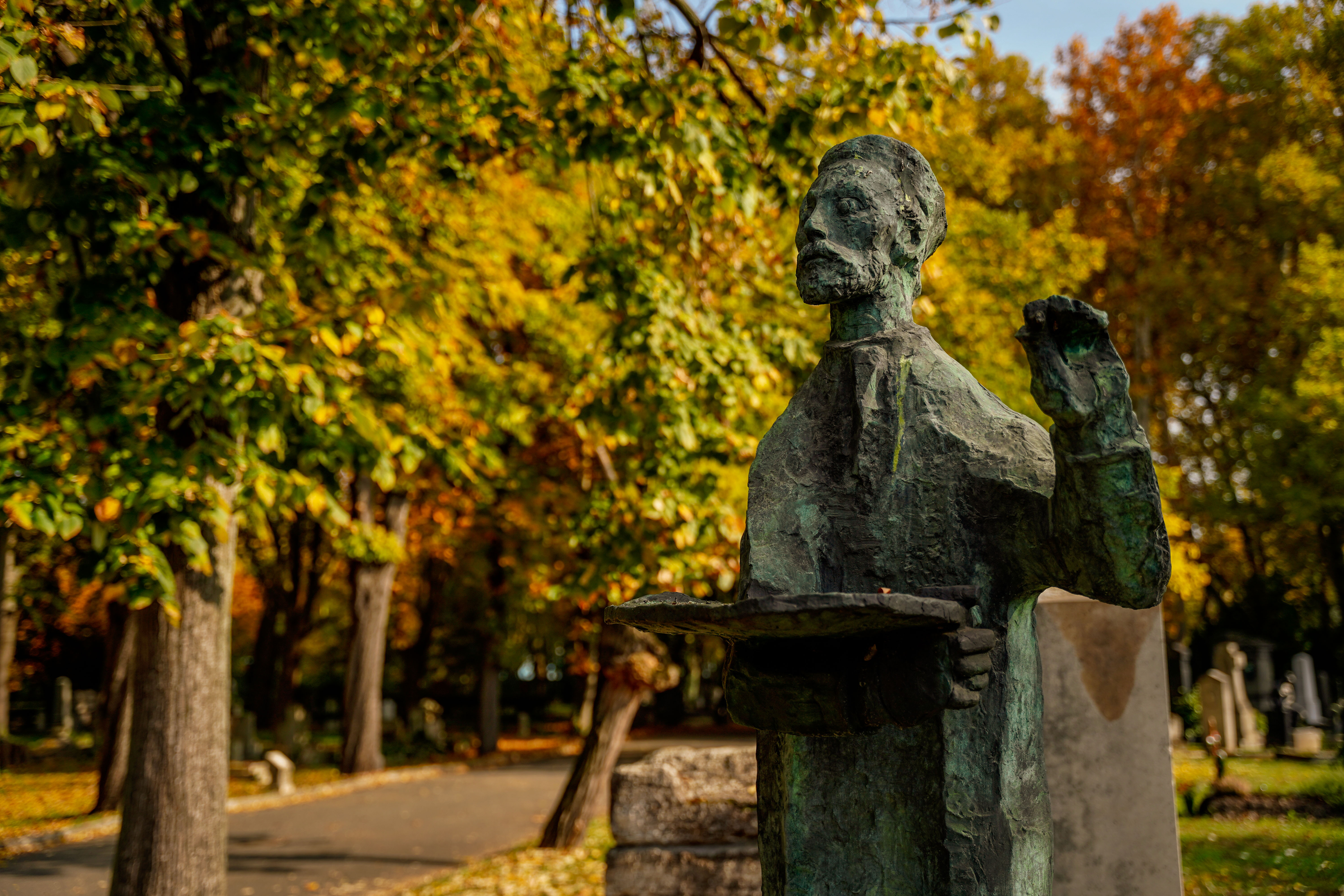 A festőművészt eredetileg az Óbudai temetőben temették el, de mivel lejárt nyughelyét nem hosszabbította meg senki, maradványait exhumálták és közös sírba helyezték át. A sírhalom megbontása és a feltárt csontok vizsgálata után 1966-ban helyezték el a festőművész vélt maradványait a Fiumei úti sírkert művészparcellájába. A síremlék elkészítésére a festő nagy rajongóját, Kerényi Jenő szobrászművészt kérték fel, aki Csontváry egész alakos figuráját mintázta meg. Az alak megformázásához a festő saját magáról készített félalakos festményét vette alapul, ahol a művész épp alkotás közben látható. A síremlék szélesen elterülő, durva felületű kőlapján álló bronzfigura jobbjában palettáját tartja, baljában pedig ecsetjét emeli magasba, amint épp a következő vonását készül meghúzni, miközben tekintete készülő művére összpontosít. A szobor, ahogy a festmény alakja is, balkezes művészről tanúskodik, azonban Csontváry az önarcképét vélhetően tükörből festette, tehát valójában Csontváry jobbkezes volt, amit egy később előkerült fotó is alátámaszt. Csontváry síremlékszobrát Kerényi művészetének egyik legkifejezőbb alkotásaként tartják számon. A mű előzménye egy 1961-ben elkészített 40 cm-es Csontváry-plasztika, az elkészült életnagyságú szobrot az 1965-ben Műcsarnokban megrendezett X. Magyar Képzőművészeti Kiállításon mutatták be. A síremlék szobrának másodpéldányát 1979-ben állították fel Pécs város közterén.
A festőművészt eredetileg az Óbudai temetőben temették el, de mivel lejárt nyughelyét nem hosszabbította meg senki, maradványait exhumálták és közös sírba helyezték át. A sírhalom megbontása és a feltárt csontok vizsgálata után 1966-ban helyezték el a festőművész vélt maradványait a Fiumei úti sírkert művészparcellájába. A síremlék elkészítésére a festő nagy rajongóját, Kerényi Jenő szobrászművészt kérték fel, aki Csontváry egész alakos figuráját mintázta meg. Az alak megformázásához a festő saját magáról készített félalakos festményét vette alapul, ahol a művész épp alkotás közben látható. A síremlék szélesen elterülő, durva felületű kőlapján álló bronzfigura jobbjában palettáját tartja, baljában pedig ecsetjét emeli magasba, amint épp a következő vonását készül meghúzni, miközben tekintete készülő művére összpontosít. A szobor, ahogy a festmény alakja is, balkezes művészről tanúskodik, azonban Csontváry az önarcképét vélhetően tükörből festette, tehát valójában Csontváry jobbkezes volt, amit egy később előkerült fotó is alátámaszt. Csontváry síremlékszobrát Kerényi művészetének egyik legkifejezőbb alkotásaként tartják számon. A mű előzménye egy 1961-ben elkészített 40 cm-es Csontváry-plasztika, az elkészült életnagyságú szobrot az 1965-ben Műcsarnokban megrendezett X. Magyar Képzőművészeti Kiállításon mutatták be. A síremlék szobrának másodpéldányát 1979-ben állították fel Pécs város közterén.
Ferenczy Noémi, bronz dombormű, 1973 (34/2-2-8)
Szobrász: Lesenyei Márta
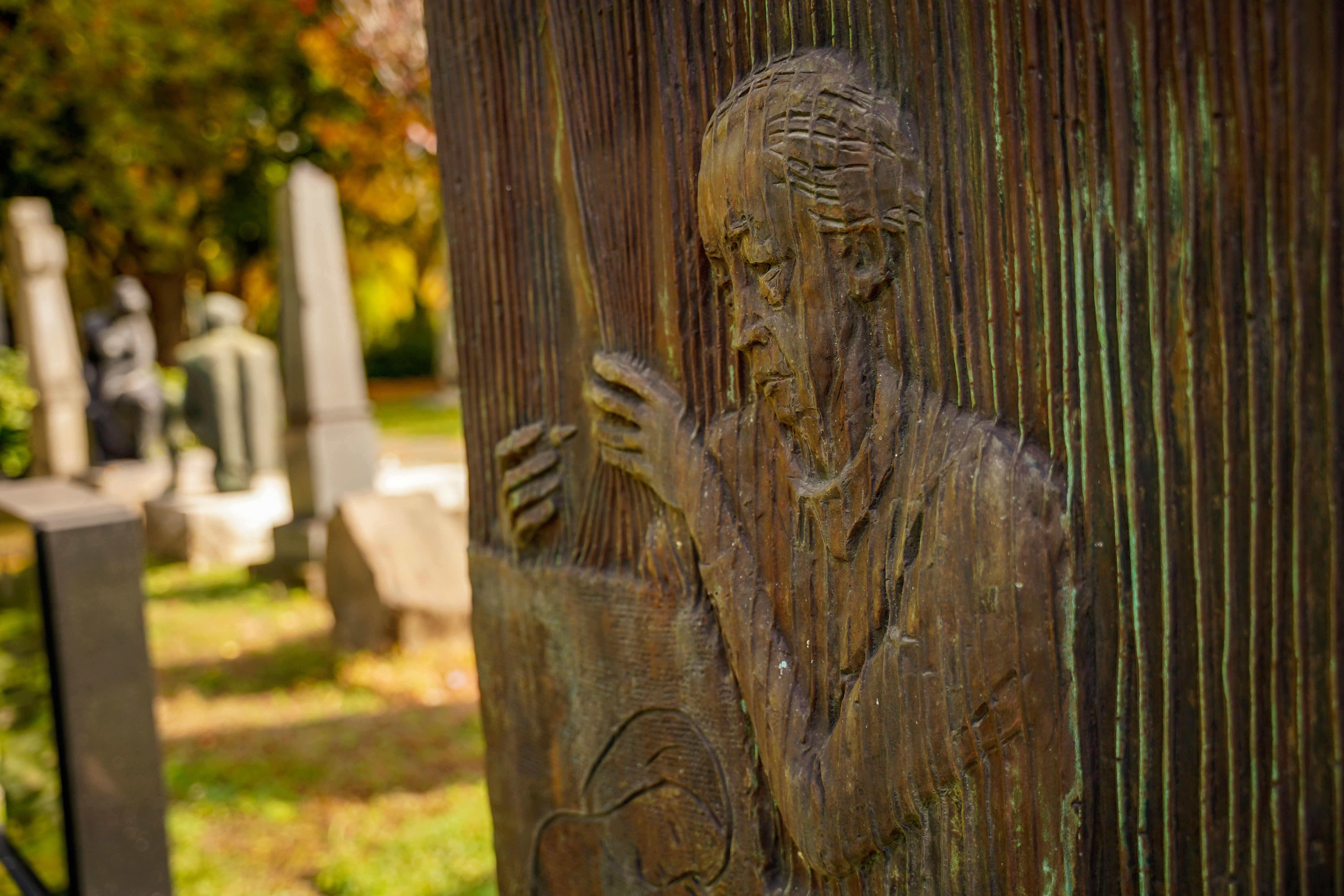 A modern magyar gobelinművészet megteremtője, Ferenczy Noémi elmélyült, befelé forduló alkat volt, aki szigorú napirend szerint élt, kora reggeltől már szövőszékén dolgozott. „Mire gondol, mialatt dolgozik?” – kérdezték egyszer a művésztől. „A munkámra” – volt a felelet. Művészetének sajátossága volt, hogy a munkafolyamat minden egyes fázisát maga végezte. Nemcsak tervezte, hanem meg is szőtte kárpitjait, a saját kezűleg festett gyapjúfonalakkal. A síremléken látható bronz dombormű munka közben ábrázolja a művészt, amint a bárányka és az őt melengető leány témáját szövi. A bárány, mint a szelídség, tisztaság, ártatlanság szimbóluma, a kiszolgáltatottságot türelmesen viselők jelképe, többször is felbukkan Ferenczy Noémi művészetében. Az állatot átölelő női alak a gyöngédség, az oltalmazás kifejezője. A domborművön látható szövőszéken készülő kárpit Ferenczy Noémi egyik híres művére, a Leány fekete báránnyal (1935) című alkotására utal, amelyben a mindenkire kiáradó gondoskodó szeretet, az oltalmazó ölelés kerül kifejezésre.
A modern magyar gobelinművészet megteremtője, Ferenczy Noémi elmélyült, befelé forduló alkat volt, aki szigorú napirend szerint élt, kora reggeltől már szövőszékén dolgozott. „Mire gondol, mialatt dolgozik?” – kérdezték egyszer a művésztől. „A munkámra” – volt a felelet. Művészetének sajátossága volt, hogy a munkafolyamat minden egyes fázisát maga végezte. Nemcsak tervezte, hanem meg is szőtte kárpitjait, a saját kezűleg festett gyapjúfonalakkal. A síremléken látható bronz dombormű munka közben ábrázolja a művészt, amint a bárányka és az őt melengető leány témáját szövi. A bárány, mint a szelídség, tisztaság, ártatlanság szimbóluma, a kiszolgáltatottságot türelmesen viselők jelképe, többször is felbukkan Ferenczy Noémi művészetében. Az állatot átölelő női alak a gyöngédség, az oltalmazás kifejezője. A domborművön látható szövőszéken készülő kárpit Ferenczy Noémi egyik híres művére, a Leány fekete báránnyal (1935) című alkotására utal, amelyben a mindenkire kiáradó gondoskodó szeretet, az oltalmazó ölelés kerül kifejezésre.
Cenotaph of Ignác Semmelweis, limestone and marble, 1894 (34/2-1-1)
Architects: Fülöp Herczog, Albert Schickedanz
 The ornate stone sarcophagus marks the former grave of Ignác Semmelweis, the famous Hungarian doctor known as ‘the saviour of mothers’. This was his fourth burial place. He was first interred in the Schmelz cemetery, then his earthly remains were transferred to the crypt of his wife’s family, the Whaltiers (right-hand wall tombs 109). The second exhumation of the doctor took place on 24 April 1894, when an ornate tomb was designated for him in plot 21 of the cemetery, for which a highly worked sarcophagus made by Albert Schickedanz and Fülöp Herczog was commissioned. From there, he was reburied in the ceremonial plots established in 1929 and the ornate sarcophagus was positioned above his remains.
The ornate stone sarcophagus marks the former grave of Ignác Semmelweis, the famous Hungarian doctor known as ‘the saviour of mothers’. This was his fourth burial place. He was first interred in the Schmelz cemetery, then his earthly remains were transferred to the crypt of his wife’s family, the Whaltiers (right-hand wall tombs 109). The second exhumation of the doctor took place on 24 April 1894, when an ornate tomb was designated for him in plot 21 of the cemetery, for which a highly worked sarcophagus made by Albert Schickedanz and Fülöp Herczog was commissioned. From there, he was reburied in the ceremonial plots established in 1929 and the ornate sarcophagus was positioned above his remains.
The name of the doctor is visible in the field surrounded by ivy symbolizing immortality on the longitudinal side of the sarcophagus worked in neo-Renaissance style and standing on lion head feet, while on the reverse side there are the dates of his birth and death. In the pearl band surrounded by a laurel wreath on the two ends of the ornate sarcophagus, the Aesculapian snake symbolizing medicine refers to the deceased vocation.
In 1965, on the 100th anniversary of his death, the earthly remains of Ignác Semmelweis were laid to final rest in the stone wall of the courtyard of the house where he was born (today, the Semmelweis Medical History Museum). The imposing tomb serves as a site of remembrance to this day.
Tomb of Ferenc Medgyessy, bronze, 1949 (34/2-1-9)
Sculptor: Ferenc Medgyessy
The statue on the grave of Ferenc Medgyessy and his wife is considered one of the artist’s key works.
 It was originally designed as a funerary statue: the famous art collector and shorthand writer Béla Radnai commissioned the artist with making a tomb for his wife. On seeing the statue being prepared in the studio, Medgyessy’s wife told her husband: “I love this statue, it would be nice if it stood above our shared grave.” The only comment of the artist was: “Maybe so, it’s a good statue.”
It was originally designed as a funerary statue: the famous art collector and shorthand writer Béla Radnai commissioned the artist with making a tomb for his wife. On seeing the statue being prepared in the studio, Medgyessy’s wife told her husband: “I love this statue, it would be nice if it stood above our shared grave.” The only comment of the artist was: “Maybe so, it’s a good statue.”
The original plaster statue depicts a full-figured female leaning against a column; she is one of the somewhat rounded-form, standing, sitting or lying female figures wearing soft folded clothing so characteristic of the Medgyessy oeuvre. An interesting feature is the inscription on the column in which one can see runic characters. The artist was particularly interested in the history of runic writing as a part of Hungarian culture, which is why runes appear in several of his works, first on a tomb depicting a young archer made in 1921.
At the request of the client, the sculptor made the female figure of the Radnai work in marble slimmer and he omitted all runic script on the column.
Several bronze copies of the plaster statue preserving the original concept were made, allowing a replica to be erected in the courtyard of the Medgyessy Ferenc Memorial Museum in Debrecen, as well as at the grave of the artist and his wife.
Grave of Lyka Károlyné (Ida Minich) and Károly Lyka, marble, 1931 (34/2-1-13)
Sculptor: Ferenc Medgyessy
 Female figures were central to the funerary art of Ferenc Medgyessy. They are shown in contrapposto pose, leaning on a stone or column, in diaphanous clothing evoking an image of Antiquity emphasizing their feminine rounded forms. These tombs bore considerable resemblance to each other, yet they were still compositions with varied solutions.
Female figures were central to the funerary art of Ferenc Medgyessy. They are shown in contrapposto pose, leaning on a stone or column, in diaphanous clothing evoking an image of Antiquity emphasizing their feminine rounded forms. These tombs bore considerable resemblance to each other, yet they were still compositions with varied solutions.
The first such funerary statue, which at the same time was Ferenc Medgyessy’s first commission for a cemetery, was made for the grave of Béla Lengyel, chemist, lying in Farkasréti Cemetery. His next one was carved in 1923 for the tomb of painter József Pechán in the cemetery of Vrbas. The funerary statue of Imre Dóczi, headmaster of the Debrecen grammar school, was ordered by his son but the plans drafted in 1931 did not meet expectations. Finally, the veiled female figure carved from marble, holding a book and musing, was erected on the grave of Lyka Károlyné, Ida Minich in 1943. In 1950, another composition with female figure was made for the grave of Radnai Béláné, and finally the bronze duplicate of this statue marks the grave of the sculptor himself.
The miniature female bronze nude (Leaning) in the same composition made by the artist in 1923 is in the collection of the National Gallery.
My Father’s Tomb, tomb of Károly Ferenczy, bronze, 1961 (34/2-1-15)
Sculptor: Béni Ferenczy
 The grave relief of Károly Ferenczy, one of the founders of the Nagybánya school of painting, was crafted by his son, Béni. Originally, the artist intended the relief Young Lovers made in 1918 to go on the grave of his father, but it was impossible to cast it in bronze because he was forced to emigrate. The plaster relief was only cast in bronze many decades later, in 2007, when it was installed on the wall of Pest Vigadó. After the Second World War he once again dusted off the plans for his father’s tomb, but this time he had to give up the project due to a serious illness, cerebral embolism. Having recovered and with his right hand paralysed, he continued working on the tomb relief for his father. The municipality undertook to cover all costs and eventually the memorial was erected on the 100th anniversary of the birth of the painter.
The grave relief of Károly Ferenczy, one of the founders of the Nagybánya school of painting, was crafted by his son, Béni. Originally, the artist intended the relief Young Lovers made in 1918 to go on the grave of his father, but it was impossible to cast it in bronze because he was forced to emigrate. The plaster relief was only cast in bronze many decades later, in 2007, when it was installed on the wall of Pest Vigadó. After the Second World War he once again dusted off the plans for his father’s tomb, but this time he had to give up the project due to a serious illness, cerebral embolism. Having recovered and with his right hand paralysed, he continued working on the tomb relief for his father. The municipality undertook to cover all costs and eventually the memorial was erected on the 100th anniversary of the birth of the painter.
The relief shows a seated woman with elbow on her knee supporting her head in her hand, staring ahead lost in contemplation. The composition brings to mind mourning, tranquil acquiescence, release and remembrance. There is a Latin inscription around the woman: Caroli Ferenczy Pictori Amici Atque Civitas MCMLXI + MCMXVII Anno Aetatis L.
Ad Astra (To the Stars), grave of Zsigmond Kisfaludi Strobl, bronze, 1922 (34/2-1-27)
Sculptor: Zsigmond Kisfaludi Strobl
In compliance with the wishes of the sculptor, a bronze casting of one of his famous works, Ad Astra, was set up on his grave.
 The artist displayed the plaster original at the exhibition organized by the Szinyei Merse Pál Society in 1922. The sculpture was also shown at the 1937 Paris World Exhibition, in the garden of the Hungarian pavilion in front of the entrance. The jury awarded the artwork a Diplôme d’Honneur (the most prestigious accolade after the Grand Prix).
The artist displayed the plaster original at the exhibition organized by the Szinyei Merse Pál Society in 1922. The sculpture was also shown at the 1937 Paris World Exhibition, in the garden of the Hungarian pavilion in front of the entrance. The jury awarded the artwork a Diplôme d’Honneur (the most prestigious accolade after the Grand Prix).
The statue depicts a youth standing on a globe. Turning towards the heavens with hands clasped to his chest, he is ready for the journey into the infinite, ‘among the stars’, as though in search of a new home for the human soul. The composition is a symbol of immortality, faith and hope. The boy preparing to depart puts one in mind of the lines of Roman poet Virgil in the Aeneid: ‘macte nova virtute puer: sic itur ad astra’, that is ‘Blessings on your fresh courage, boy, so it is man rises to the stars’.
The work was originally designed as an allegorical funerary statue, several copies of which were erected on tombs, but there are also examples in the public domain. A replica was installed on the grave of András Halász, one-time chief engineer of the capital, in Farkasréti Cemetery, and of course on the grave of the sculptor.
It was unveiled as a public statue in Siófok in 1943 as a memorial to István Horthy, vice-regent; a reworked copy was inaugurated in 2013. A duplicate was erected in front of Göcseji Museum, Zalaegerszeg, in 1984; the museum preserves and displays several statues from the bequest of the Zala artist.
Grave of Tivadar Csontváry Kosztka, bronze, 1965 (34/2-1-14)
Sculptor: Jenő Kerényi
 Originally, the painter was buried in Óbuda cemetery, but when the lease on the resting place was not extended his mortal remains were exhumed and transferred to a common grave. In 1966, the burial site was excavated and the bones discovered there were examined, after which the remains thought to be those of the painter were again transferred, this time to the Artists’ plot of Fiumei Road Cemetery. A great admirer of the painter, sculptor Jenő Kerényi, was commissioned with making the grave memorial. He modelled a full-figure statue of Csontváry. When it came to shaping the figure, the sculptor based his work on a self-portrait made by the painter, where the artist can be seen at work. The bronze, standing on a rough-hewn, wide stone plinth, is shown with palette in his right hand and in his left a brush held high, which he is just about to use to make the next brushstroke, while his attention is focused on his work in progress. The statue, just like the self-portrait, suggests that the artist was left-handed, although it is likely that Csontváry painted the self-portrait from a mirror, thus in fact he was right-handed, something that a photo unearthed later on confirmed. Csontváry’s grave sculpture is considered one of the most expressive works of art by Kerényi. The work was preceded by a 40-cm-high Csontváry statuette made in 1961; the finished, life-size statue was displayed at the 10th Hungarian Fine Arts Exhibition held at the Kunsthalle in 1965. A copy of the grave statue was erected in a square in Pécs in 1979.
Originally, the painter was buried in Óbuda cemetery, but when the lease on the resting place was not extended his mortal remains were exhumed and transferred to a common grave. In 1966, the burial site was excavated and the bones discovered there were examined, after which the remains thought to be those of the painter were again transferred, this time to the Artists’ plot of Fiumei Road Cemetery. A great admirer of the painter, sculptor Jenő Kerényi, was commissioned with making the grave memorial. He modelled a full-figure statue of Csontváry. When it came to shaping the figure, the sculptor based his work on a self-portrait made by the painter, where the artist can be seen at work. The bronze, standing on a rough-hewn, wide stone plinth, is shown with palette in his right hand and in his left a brush held high, which he is just about to use to make the next brushstroke, while his attention is focused on his work in progress. The statue, just like the self-portrait, suggests that the artist was left-handed, although it is likely that Csontváry painted the self-portrait from a mirror, thus in fact he was right-handed, something that a photo unearthed later on confirmed. Csontváry’s grave sculpture is considered one of the most expressive works of art by Kerényi. The work was preceded by a 40-cm-high Csontváry statuette made in 1961; the finished, life-size statue was displayed at the 10th Hungarian Fine Arts Exhibition held at the Kunsthalle in 1965. A copy of the grave statue was erected in a square in Pécs in 1979.
Noémi Ferenczy, bronze relief, 1973 (34/2-2-8)
Sculptor: Márta Lesenyei
 The founder of modern Hungarian gobelin art, Noémi Ferenczy, was an intense, introverted person, who lived according to a rigorous daily schedule, working at the weaving loom from early morning. “What are you thinking of while you work?” the artist was once asked. “My work,” she replied. The particular feature of her art was that she herself carried out every single phase of the process. She not only designed but wove her tapestries using wool thread she had dyed herself. The bronze relief on the grave shows the artist at the loom; the work she is weaving is of a woman cradling a lamb. The lamb as symbol of gentleness, purity and innocence, those who bear vulnerability with forbearance, appears in the art of Noémi Ferenczy on several occasions. The female figure cradling the animal is an expression of tenderness and protection. The tapestry being woven on the loom in the relief refers to one of Noémi Ferenczy’s famous works, Girl with Black Lamb (1935), which expresses caring love pouring out to everyone, the protective embrace.
The founder of modern Hungarian gobelin art, Noémi Ferenczy, was an intense, introverted person, who lived according to a rigorous daily schedule, working at the weaving loom from early morning. “What are you thinking of while you work?” the artist was once asked. “My work,” she replied. The particular feature of her art was that she herself carried out every single phase of the process. She not only designed but wove her tapestries using wool thread she had dyed herself. The bronze relief on the grave shows the artist at the loom; the work she is weaving is of a woman cradling a lamb. The lamb as symbol of gentleness, purity and innocence, those who bear vulnerability with forbearance, appears in the art of Noémi Ferenczy on several occasions. The female figure cradling the animal is an expression of tenderness and protection. The tapestry being woven on the loom in the relief refers to one of Noémi Ferenczy’s famous works, Girl with Black Lamb (1935), which expresses caring love pouring out to everyone, the protective embrace.
Vissza a szoborpark listára